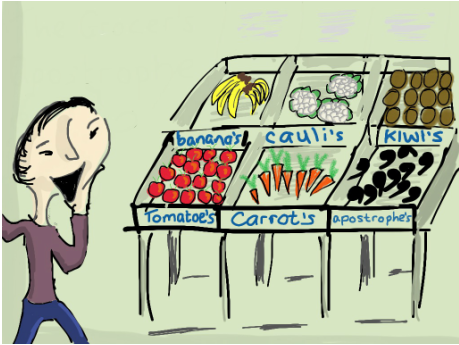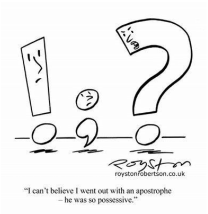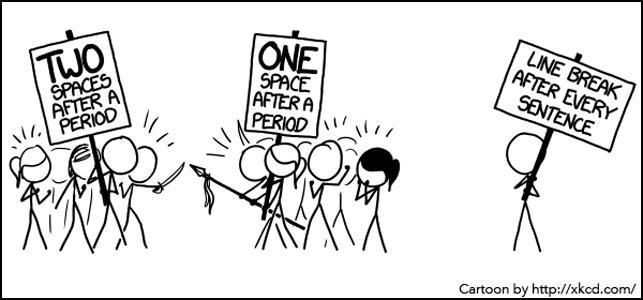Cartoon courtesy Juliet Fay, "How the Grocer's Apostrophe led to generations of confused writers.” Web Source: http://carondann.com/tag/grocers-apostrophe/
Yes, I know. Irritating isn't it! But the number of people who do this is incredible.
Working in a junior school it is something I come across every day. But then you would expect that - it’s one of the things the children are there for: to learn how to use apostrophes with contractions or possessives.
How many times have you been to a restaurant or café and seen apostrophes wrongly used on the menu? Or in a shop, or on a leaflet … I could go on.
What I can’t understand is why people don’t have their menu/leaflet/poster proofread before it goes to print - it makes it look unprofessional if there are silly errors. It isn’t too hard to remember that apostrophes are used:
Remember - if it’s a plural do not use an apostrophe:
The other problem with apostrophes is what to do if it is a possessive name ending in “s”:
Which is the correct way to use the apostrophe? Actually, both are acceptable, so long as you make sure you are consistent.
For possessive plural names, stick the apostrophe after the “s”, ie, “We travel in the Browns' bus when we visit the Joneses (members of the Jones family) at the Joneses' home.” When the last name ends with a hard "z" sound, you usually don't add an "s" or the "-es" but just add the apostrophe: "the Chambers' new puppy."
The most important rule to remember then is:
If it is a plural do not use an apostrophe
Yes, I know. Irritating isn't it! But the number of people who do this is incredible.
Working in a junior school it is something I come across every day. But then you would expect that - it’s one of the things the children are there for: to learn how to use apostrophes with contractions or possessives.
How many times have you been to a restaurant or café and seen apostrophes wrongly used on the menu? Or in a shop, or on a leaflet … I could go on.
What I can’t understand is why people don’t have their menu/leaflet/poster proofread before it goes to print - it makes it look unprofessional if there are silly errors. It isn’t too hard to remember that apostrophes are used:
- for possessive nouns: so if a noun owns something use an apostrophe, ie, Bob’s ice cream had melted in the sun’s heat
- when you use contractions: to shorten a word by removing one letter or more and substituting an apostrophe in the same spot, ie, Bob’s going to the shop to buy another ice cream
Remember - if it’s a plural do not use an apostrophe:
- ice creams always melt in the sun
- bananas are on offer today
The other problem with apostrophes is what to do if it is a possessive name ending in “s”:
- Chris’s bike was the best on the block
- Chris’ bike was the best on the block
Which is the correct way to use the apostrophe? Actually, both are acceptable, so long as you make sure you are consistent.
For possessive plural names, stick the apostrophe after the “s”, ie, “We travel in the Browns' bus when we visit the Joneses (members of the Jones family) at the Joneses' home.” When the last name ends with a hard "z" sound, you usually don't add an "s" or the "-es" but just add the apostrophe: "the Chambers' new puppy."
The most important rule to remember then is:
If it is a plural do not use an apostrophe
If you’ve come across any apostrophe errors, I’d love to hear about them. Feel free to post any comments or photos either at the end of this page or on my MB Proofreading Facebook page.





